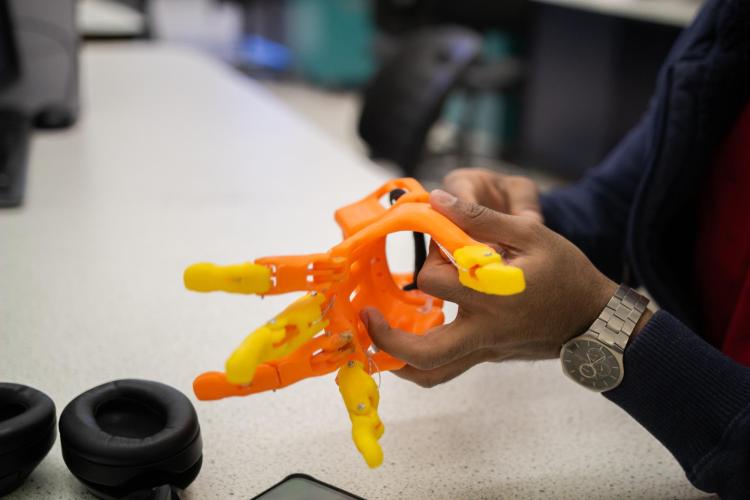ME Course Column: Bio-inspired Robotics
The ME Course Column is a recurring publication about the unique classes and labs that mechanical engineers can take while at the University of Colorado Boulder. Follow the series to understand the core curriculum, discover elective course options and learn the broad applications of mechanical engineering skills.
Bio-inspired robotics is the interface of biology and engineering – motivating the development of technology from artificial muscles and medical devices to gecko-inspired adhesives and robots that run, fly and swim.

Professor Kaushik Jayaram
Header image: Students remodeled CAD hand using bio-inspired robotics.
The field focuses on solving technical problems with designs inspired by nature – going beyond the idea of simply copying existing biological solutions.
MCEN 4228/5228: Bio-inspired Robotics introduces engineers to this area of study. Taught by Professor Kaushik Jayaram, the course compels students to develop useful solutions for societal issues by combining mechanisms in biological solutions with best human practices. Students learn to translate the principles of function, performance and aesthetics from biology to human technology.
“At a very high level, this course is about understanding the philosophy of what bio-inspired engineering is,” Jayaram said. “Since this is a fundamentally interdisciplinary field, we cannot do bio-inspiration in isolation.”
Jayaram introduces students to a series of projects and case studies to understand successful approaches to bio-inspired robotics. One of the projects involves students modifying 3D-printed hands with biological inspirations from an animal of their choice.
“Basically, they start off with a CAD model and then add to it,” Jayaram said. “For example, koalas have six fingers – two thumbs on each hand. Some groups get inspiration from that and find their model is better at gripping."
Bio-inspired Robotics culminates in students designing and building their own bio-inspired devices. They start by identifying a novel biological discovery that can be translated to an application for technology.
Students have developed ideas to advance robotic locomotion. They have channeled biological solutions like webbed feet and fins for better movement in water or wings for maximum energy motion in flight.
Other projects have resulted in algorithms and simulated software inspired by how rats use their sense of touch and smell to navigate complex mazes. Another group looked at the surface of leaves and their condensation abilities to build a water filter for desert areas.

CAD hand remodeled with fingers oriented in different directions for flexible gripping.
“There is a wide range of examples from animals to plants and in both hardware and software,” Jayaram said. “Somebody who is working in this field needs to have a strong understanding of biology, a strong understanding of different kinds of engineering and potentially have an understanding about art, ethics and society.”
While the inventive and technical processes of Bio-inspired Robotics prepare students to enter a variety of engineering fields, the creative and insightful aspects also strengthen their prospects in entrepreneurship.
Jayaram wants to eventually open the course to students outside of science fields because of the interdisciplinary nature of bio-inspired engineering. This would mean including students with diverse backgrounds such as business, humanities and the arts.
Bio-inspired Engineering is currently open to juniors, seniors and graduate students in mechanical and biomedical engineering, as well as those studying engineering management.

